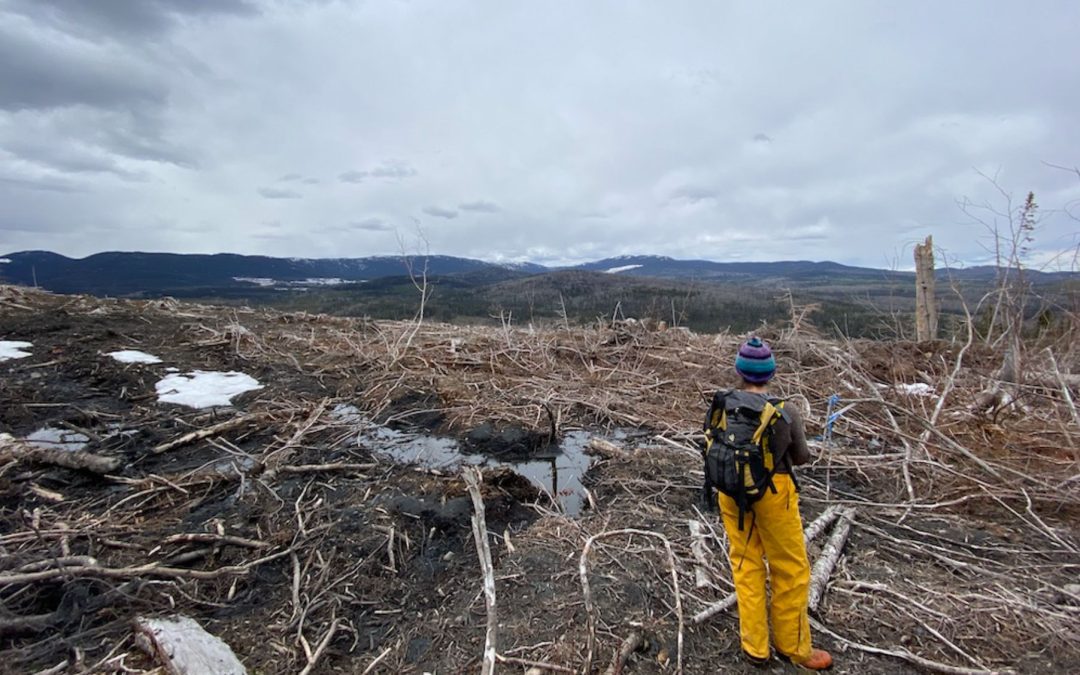Three years after the Old Growth Strategic Review, the province has made three big recent announcements. A Tyee explainer.
At the northern edge of the province, along the Rocky Mountain Trench, the Mackenzie timber supply area, which covers 6.4 million hectares, has faced an onslaught of pine beetles and wildfires peeling through its vast forests of fir, spruce and lodgepole pine.
For decades, major forest companies heavily clear cut the forests in the southern part of the timber supply area, where the drive to nearby mills was cheapest on gas.
The ecosystem has suffered. One herd of southern mountain caribou in the timber supply area is now extirpated, for example, while others are red-listed.
The chief forester tried to lessen the blow with a non-legal “partition” to limit the weight of timber that companies could log from the hard-hit southwestern region. But companies didn’t follow it — in part because the government issued permits for them to log two and a half times more timber than the partition allowed.
This year, the province set a rate of cut it acknowledges is likely to put caribou and fish-bearing watersheds at risk.
Mackenzie is just one of many timber supply areas in B.C. pushing up against ecological limits.
“The province’s biodiversity and ecosystems are under threat,” wrote Minister of Water, Land and Resource Stewardship Nathan Cullen in the province’s new plan to transform its timber-first approach to forest and land management. Its Biodiversity and Ecosystem Health Framework is one of three announcements this fall to realize its goal.
“You get so used to thinking about land as something you can do whatever we want with,” said Garry Merkel, co-author of the province’s Old Growth Strategic Review that set B.C.’s “paradigm shift” into motion.
“You’ve got to change your idea about it to ‘I’m looking after it first, and it’ll look after me,’” Merkel said. “That’s a big shift in thinking.”
A month earlier, the federal government, B.C. and the First Nations Leadership Council announced the Tripartite Framework Agreement on Nature Conservation to protect 30 per cent of B.C.’s lands and waters by 2030, setting aside $1 billion in funding to get there. A week before that, the province launched a “conservation financing mechanism” that will determine how funding gets distributed.
These three announcements — the Biodiversity and Ecosystem Health Framework, the Tripartite Framework Agreement on Nature Conservation and the conservation financing mechanism — each cited another shift B.C. has committed to: First Nations would co-develop the laws and policies to come. This was the first recommendation of the Old Growth Strategic Review, aimed at unrooting the long erasure of Indigenous nations’ jurisdiction and rights over their land.
This “paradigm shift” will be put to the test as the announcements give way to their promised councils, negotiations and eventual decisions.
Robert Phillips, the political executive for the First Nations Summit, is encouraged by the intentions so far, but wary of the time-worn grooves of inaction.
“We don’t have the luxury of time,” he said.
How will the old processes change?
For decades, B.C.’s forest industry has been ruled by the steady beat of the allowable cut determination. Every five or 10 years, the province’s chief forester decides how much wood companies can log in a given region. The goal of the process is to keep enough trees in the forest to keep the industry running; it isn’t designed or meant to address things like biodiversity or old-growth forest protection, which it assumes the province has made separate decisions about.
To determine the allowable annual cut, the chief forester starts with a baseline calculation of the amount of trees in a given area and how fast they grow, and then removes things like land impacted by natural disasters such as wildfires and so-called “constraints” like parks and protected areas, as well as an assortment of in-between designations, like old-growth management and wildlife habitat areas, many of them designed in the 1990s, grafted for decades onto a maze of rules and sometimes loopholes.
In the Mackenzie TSA and in other regions throughout the province, those “constraints” are not adequate to protect key ecosystems and habitat.
In Mackenzie, for example, areas earmarked for caribou habitat are largely high-elevation forests; in the winter months, caribou are typically searching for low-lying pine stands, which tend to be more threatened by logging.
The chief forester’s partition to limit logging in the southwest region of the timber supply area was meant to address this and other ecological issues, but companies logged far beyond the partition limit anyway.
Merkel says the province’s new framework will flip its approach to land management on its head. In this version, ecological health replaces timber as the baseline. Once that ecological health baseline has been established, Merkel says, decisions can be made about what kinds of economic activity the ecosystem can support.
“You can take some things out and you can alter it slightly, but you can’t do too much or it starts to disintegrate and fall apart,” Merkel said.
In places like the Mackenzie TSA, that could mean the ecosystem’s health will now be assessed and prioritized before logging and other industries get the go-ahead. It could also mean that tools to support the ecosystem would be legally enforced and monitored — unlike the Mackenzie TSA’s non-legal partition, which companies ignored.
In an email, the Ministry of Forests said it takes the companies’ overcut in the Mackenzie TSA “very seriously” and pointed to last month’s amendments to the Forest Act that increase government’s power to withhold cutting permits if objectives like stewardship aren’t met.
